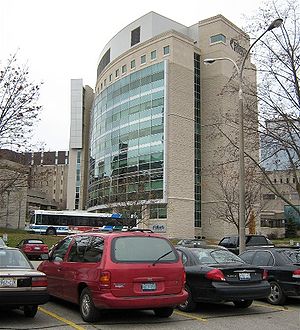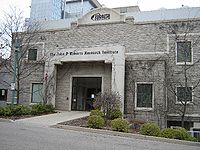
Robarts Research Institute
Encyclopedia

London, Ontario
London is a city in Southwestern Ontario, Canada, situated along the Quebec City – Windsor Corridor. The city has a population of 352,395, and the metropolitan area has a population of 457,720, according to the 2006 Canadian census; the metro population in 2009 was estimated at 489,274. The city...
, Ontario
Ontario
Ontario is a province of Canada, located in east-central Canada. It is Canada's most populous province and second largest in total area. It is home to the nation's most populous city, Toronto, and the nation's capital, Ottawa....
, Canada with a staff of more than 600 people. Robarts scientists include physicians and physicists, biologists and biomedical engineers, and the range of diseases they study include heart disease
Heart disease
Heart disease, cardiac disease or cardiopathy is an umbrella term for a variety of diseases affecting the heart. , it is the leading cause of death in the United States, England, Canada and Wales, accounting for 25.4% of the total deaths in the United States.-Types:-Coronary heart disease:Coronary...
, stroke
Stroke
A stroke, previously known medically as a cerebrovascular accident , is the rapidly developing loss of brain function due to disturbance in the blood supply to the brain. This can be due to ischemia caused by blockage , or a hemorrhage...
, diabetes, Alzheimer's disease
Alzheimer's disease
Alzheimer's disease also known in medical literature as Alzheimer disease is the most common form of dementia. There is no cure for the disease, which worsens as it progresses, and eventually leads to death...
, and many forms of cancer
Cancer
Cancer , known medically as a malignant neoplasm, is a large group of different diseases, all involving unregulated cell growth. In cancer, cells divide and grow uncontrollably, forming malignant tumors, and invade nearby parts of the body. The cancer may also spread to more distant parts of the...
. It is also well known for its medical imaging
Medical imaging
Medical imaging is the technique and process used to create images of the human body for clinical purposes or medical science...
research. Robarts was amalgamated with the University of Western Ontario in July 2007, leaving the Perimeter Institute as the only independent scientific research institution in Canada.
History
The institute was founded in 1986, under the guidance of neurologistNeurology
Neurology is a medical specialty dealing with disorders of the nervous system. Specifically, it deals with the diagnosis and treatment of all categories of disease involving the central, peripheral, and autonomic nervous systems, including their coverings, blood vessels, and all effector tissue,...
Dr. Henry Barnett
Henry Barnett
Henry Joseph Macaulay Barnett, is a Canadian physician, a leading stroke researcher and pioneer of the use of aspirin for stroke prevention....
, most famous for his work with Aspirin
Aspirin
Aspirin , also known as acetylsalicylic acid , is a salicylate drug, often used as an analgesic to relieve minor aches and pains, as an antipyretic to reduce fever, and as an anti-inflammatory medication. It was discovered by Arthur Eichengrun, a chemist with the German company Bayer...
as a preventive therapy for heart attack
Myocardial infarction
Myocardial infarction or acute myocardial infarction , commonly known as a heart attack, results from the interruption of blood supply to a part of the heart, causing heart cells to die...
and stroke. Dr. Mark J. Poznansky became scientific director in 1993 and was awarded the Order of Canada
Order of Canada
The Order of Canada is a Canadian national order, admission into which is, within the system of orders, decorations, and medals of Canada, the second highest honour for merit...
in 2005 for his work. He resigned in March 2007 and formed G2G Consulting Inc.
Dr. John MacDonald, the current Scientific Director, joined the Institute July 1, 2008 and holds a PhD from the University of British Columbia and has conducted postdoctoral work at the University of St. Andrews, UK, McGill University, and the National Institutes of Health in Bethesda, Maryland.
Current Ongoing Research

Research interests include:
ALS (Lou Gehrig’s disease),
Alzheimer’s disease,
Arthritis,
Atherosclerosis,
Biomedical engineering,
Biophysics,
Brain chemistry/function,
Brain imaging,
Cancer,
Cardiovascular imaging,
Cell biology,
Cell signalling,
Cellular & micro-imaging,
Clinical trials,
CT imaging,
DNA sequencing,
Diabetes,
Diagnostic imaging,
Epilepsy,
Functional MRI,
Genetics/genomics,
Heart disease,
High blood pressure,
Image-guided surgery & therapy,
Immune responses,
Immunotherapeutics,
Magnetic Resonance Imaging (MRI),
Multiple sclerosis,
Musculoskeletal imaging,
Organ rejection,
Osteoporosis,
Parkinson’s disease,
Poxvirus,
Schizophrenia,
Spinal cord injury,
Stroke,
Technology transfer,
Transplantation immunology,
Ultrasound imaging,
Virology,
Xenotransplantation

